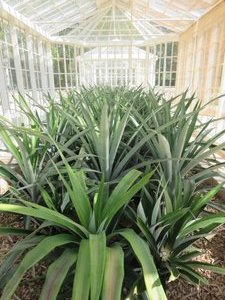Advertisement
Published: October 9th 2017

 National palace of Queluz
National palace of Queluz
One of the green houses dating back to the 1770sWe decided we needed a trip outside of Lisboa today, and settled on a visit to the National Palace of Queluz. It was an easy 20 minute trip by train from the Rossio Station, which is a 20 minute walk from our apartment. We used our transit cards, so it's even easier!
One of the guide books had inferred that the area around the train station at the palace stop is "sketchy", but it just turned out to be "not white majority" and perfectly safe. I asked a young woman for directions, and she volunteered to walk us the 15 minutes to the palace! She is visiting family here for a year, but is from Cape Verde.
Once at the Palace, we paid for our reduced senior rate tickets (still $10/each, but well worth it) and entered this massive structure. It was begun in 1684 as a royal country house, added on to over the years, and transformed into the summer palace in 1747. After the Lisboa palace burnt in 1794, it became the main residence of the royal family.
And now it gets interesting: The regent King John IV fled from the palace ahead of Napoleon in 1807, taking his family and court with him to Brazil! He was the first European monarch to set foot on the Americas. The story of his son, Pedro, is even more amazing. He was born in 1798 and only nine was his family moved to Brazil. By the way, his full name was Pedro de Alcântara Francisco António João Carlos Xavier de Paula Miguel Rafael Joaquim José Gonzaga Pascoal Cipriano Serafim.
Pedro loved physical activity, and was an expert horseman. He liked talking with the common people and would often go out in disguise. He also loved women... In 1817 at age 19, he was married ,to Archduchess Maria Leopoldina, daughter of Emperor Franz I of Austria, with whom he had seven children. He had multiple children from other relationships, and was a good father to them all, it is said. In 1821, Pedro became Emperor of Brazil. He was staunch supporter of liberalism and of constitutional representative monarchy. He had read the works of Voltaire, Benjamin Constant, Gaetano Filangieri and Edmund Burke. The Emperor received word that his father had died on 10 March 1826, and that he had succeeded his father on the Portuguese throne as King Dom Pedro IV. Aware that a reunion of Brazil and Portugal would be unacceptable to the people of both nations, he hastily abdicated the crown of Portugal on 2 May in favor of his eldest daughter, who became Queen Dona Maria II. (and who married her uncle...).
In 1831, Pedro abdicated and returned to Portugal, to fight for his daughter's right to the throne. During the war in Porto in 1833, the Duke of Braganza, a the title by which he was now known, mounted cannons, dug trenches, tended the wounded, ate among the rank and file and fought under heavy fire as men next to him were shot or blown to pieces. While always of robust health, he contracted tuberculosis, and by 1834, was confined to bed at the Palace of Queluz, in the room where he was born. before he died, Pedro dictated an open letter to the Brazilians, in which he begged that a gradual abolition of slavery be adopted. He warned them: "Slavery is an evil, and an attack against the rights and dignity of the human species, but its consequences are less harmful to those who suffer in captivity than to the Nation whose laws allow slavery. It is a cancer that devours its morality." (with help from Wikipedia)
A peace accord was signed in May of 1834, and Pedro died in September. He was only 36! After we toured the Palace, we spend the rest of the afternoon roaming the extensive grounds and gardens. The Palace was turned over the government in 1908, and is now recently been taken over by what seems to be a private group, who are doing major restoration of the gardens. There are riding stables, a canal, orchards, a botanical garden, dozens of water features, and two formal gardens.
After we got back to Lisboa, I went to a thrift shop, and Bill went home. We had dinner in tonight: really good frozen pizzas from the grocery store...
Advertisement
Tot: 0.101s; Tpl: 0.016s; cc: 10; qc: 24; dbt: 0.0503s; 1; m:domysql w:travelblog (10.17.0.13); sld: 1;
; mem: 1.1mb


























